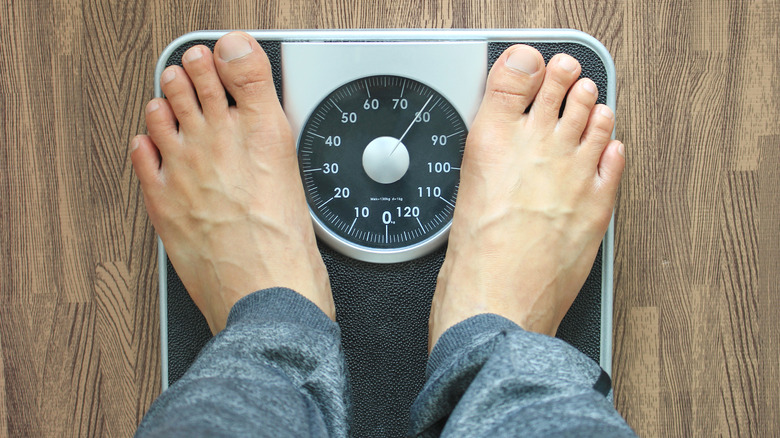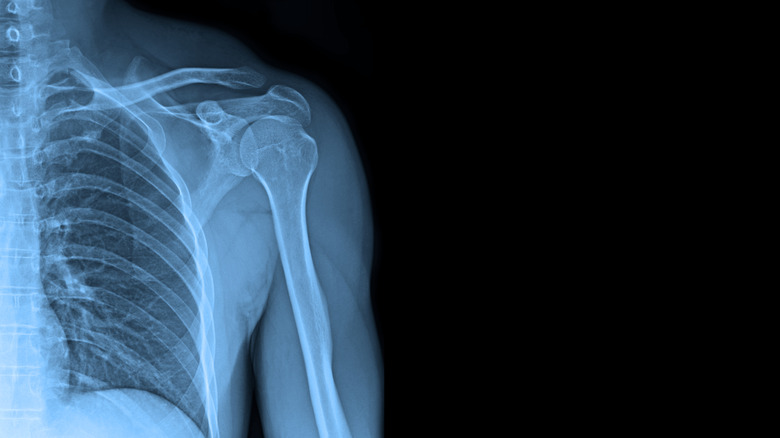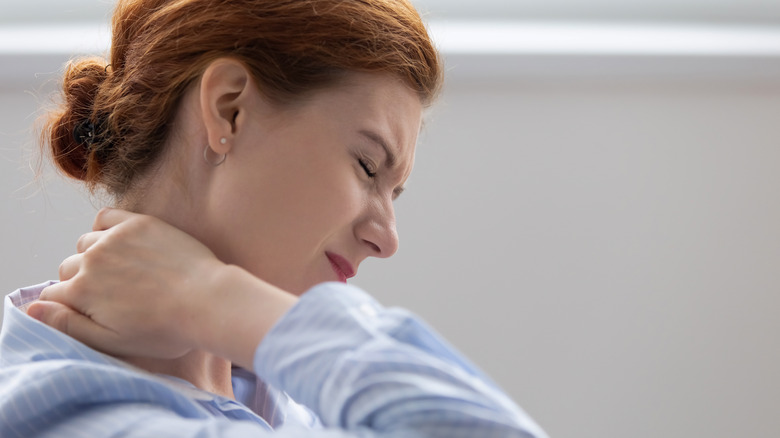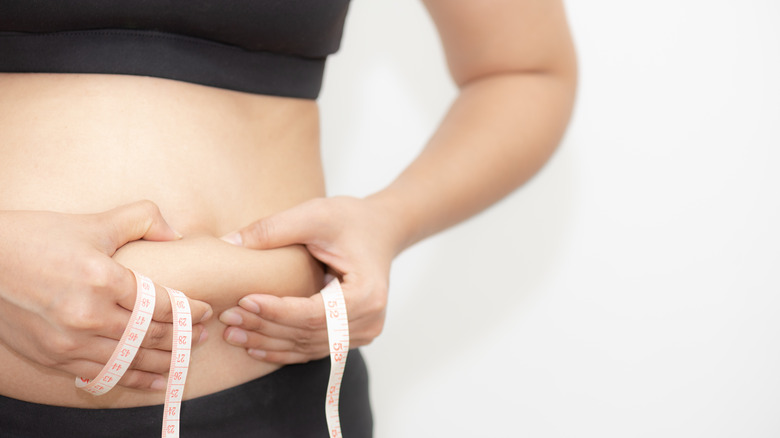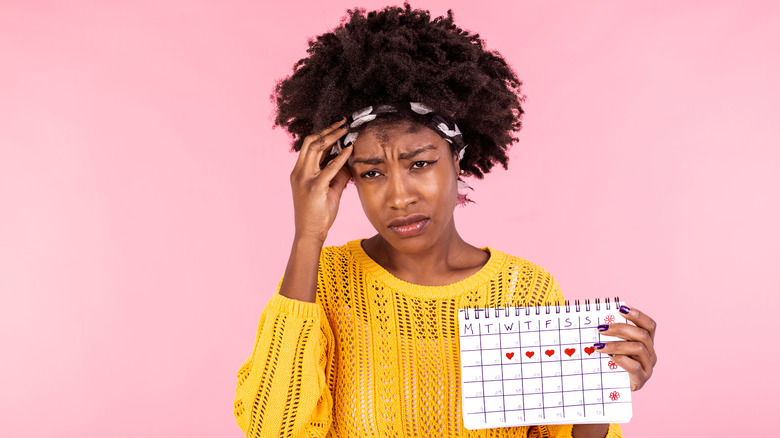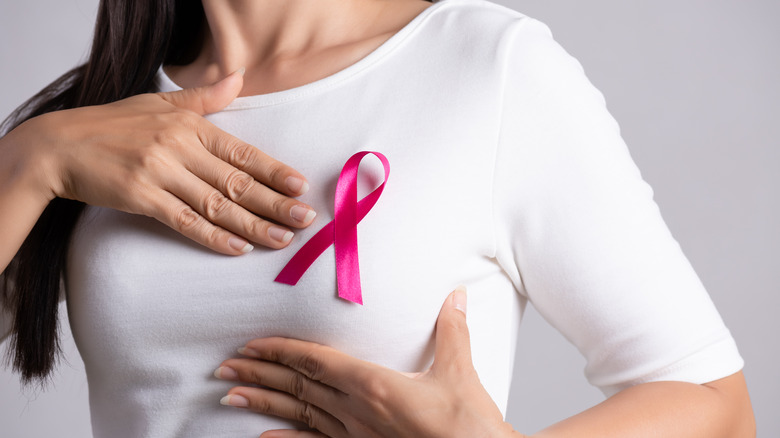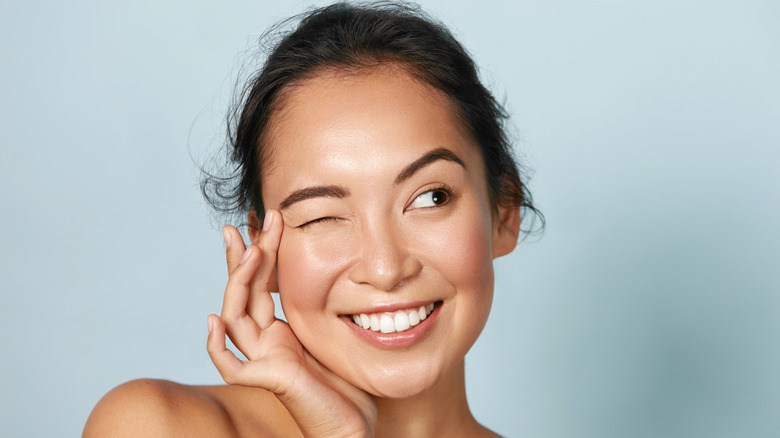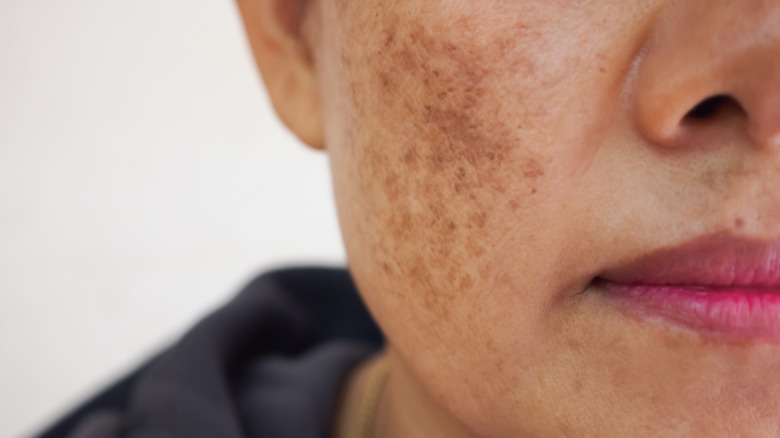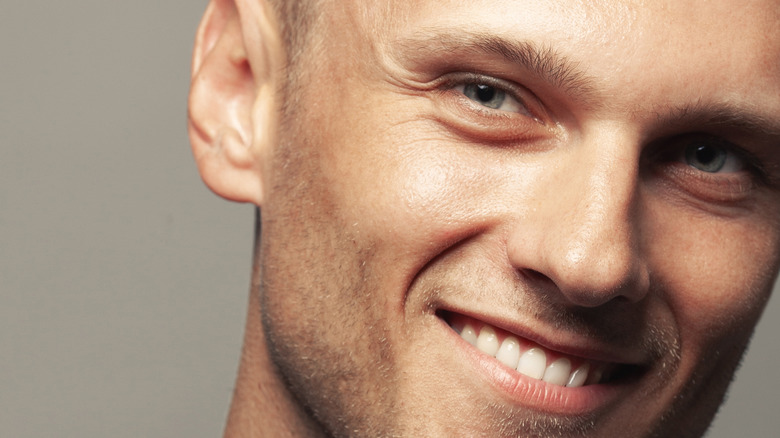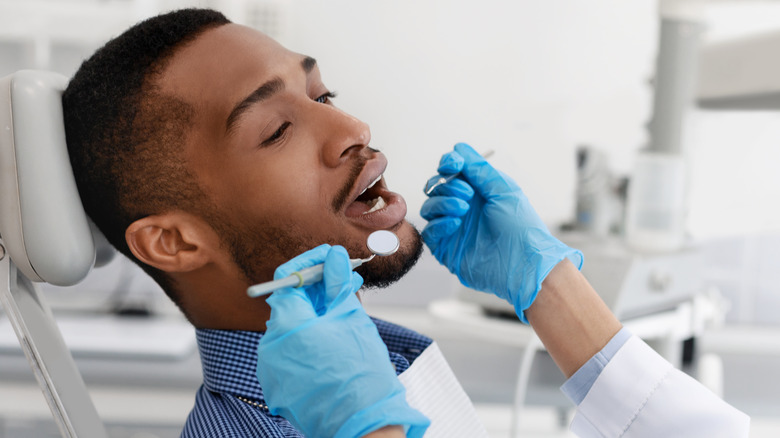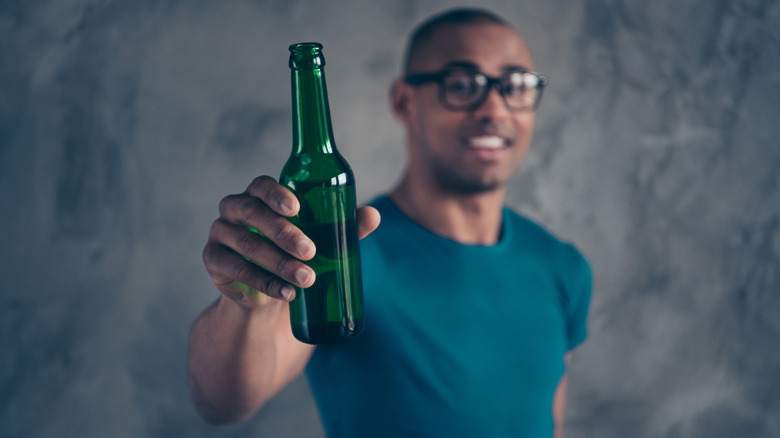Surprising Things That Happen To Your Body After You Turn 30
Some people view aging as a rite of passage and respect the knowledge that those who came before us pass down. Others run from aging like it is Jason Voorhees in "Friday the 13th."
Disregarding Hollywood's aesthetic preference for the young and nubile, we want to know what happens to the body after turning 30. Specifically, we want to understand the physiology behind the Botox and fillers. We have so many options to help us stay youthful in appearance, but there is more to everyone than meets the eye. And, well, some of the things that happen to the tricenarian's body are downright weird. Other things are predictable, and others still are hard to talk about in public.
From a change in body tissue to a change in the color and texture of your hair, here are some of the most interesting things that happen to your body after you turn the big 3-0.
You'll lose lean tissue
Unfortunately, many of the things that happen to your body after you turn 30 include the loss of things that you probably like having around. One of the main things that we start to lose after 30 is lean tissue. This includes the atrophy of the muscles and a decrease in cells in some organs, such as the kidneys and liver, explained Medline Plus.
To add insult to injury here, it is perfectly natural for body fat mass to increase as we age. According to Medline Plus, the amount of body fat you have rises steadily year after year beyond 30. They estimate that most older people have a third more body fat than when they were younger.
This makes us think we should actually throw out our emo skinny jeans from high school, you know, the ones with the My Chemical Romance patch sewn to the back pocket. Y'all know we do not fit into those anymore. We're sorry, Gerard, we still love you.
Bye-bye, bone mineral density
After turning 30, your bone mineral density will decline. While this is totally normal, it can lead to unpleasant consequences down the road (via Medline Plus). While the loss of bone density can affect men and women alike, it is more common in women. In its early stages, this is classified as osteopenia. Once the loss of bone mineral density reaches a certain point, it is considered osteoporosis, which directly translates into "porous bone," explained the Cleveland Clinic.
The loss of bone minerals and lean tissues can result in the physical shortening of our bodies, according to Medline Plus. We now realize it was unfair to measure our height against our grandmas while growing up. As we were getting taller, they were getting shorter!
To combat this loss of bone minerals, the experts at Johns Hopkins recommend a few preventative actions, like ensuring that you are consuming enough calcium, vitamin D, and protein. They also advise engaging in regular weight-bearing exercise and resistance training in addition to avoiding smoking and minimizing alcohol consumption.
Your joints may become stiff
Years of use can create stiffness in your joints. While many deeper health reasons could be at the root of excessively stiff joints, many of us will experience stiffness throughout our lifetime (via Healthline). If your joint stiffness seems far beyond normal, we recommend seeing a doctor to ensure there isn't a deeper ailment lurking beneath the surface.
Nevertheless, joint stiffness from age is totally normal. We may experience it after long periods of sitting or lying down. After a long night's sleep, joint stiffness is common because of the lack of fluid our joints receive during our slumber, explained Healthline. Typically after a bit of movement, joint capsules loosen up, and we are all able to go about our days. Of course, the older we get, the more severe the stiffness may be. Healthline recommends hot or cold to soothe stiff joints. Both extreme temps can help ease stiffness, whether it's from overuse or accompanied by inflammatory conditions.
Your body fat percentage may increase
The increase in body fat mass as we age has a lot to do with the loss of lean mass. These changes start to take place shortly after reaching our third decade on earth, revealed Medline Plus. Typically, the layer of fat beneath the skin gets thinner, but the amount of fat surrounding the organs increases. The latter type of fat is called visceral fat, while the fat beneath the skin is called subcutaneous fat. It is perfectly natural for your visceral fat to increase with age, but too much of it can have negative health consequences (via WebMD).
To add insult to injury here, an increase in body fat mass can cause changes in your balance and proprioception as well! Though less likely to occur within the 30-year old crowd, the change in shape and additional body fat mass can create instability and a lack of coordination. Unfortunately, this leaves us more prone to injury-inducing tumbles, per Medline Plus. Though this process often begins around 30 years of age, it likely will not become an issue for men until after turning 55 and for women 65 and older.
You'll go through 'second puberty'
Experts often call the natural transition from 20s to 30s a "second puberty," according to Healthline. These changes are marked by slow decreases in our main sex hormones.
In women, second puberty is characterized by a change in skin texture, vaginal dryness, irregular periods, and gray hair. These changes are indicative of perimenopause and often begin in the third decade of life. Typically, these signs won't gain traction until a woman reaches her 40s, but whisperings of this change can become apparent early on (via Healthline). And by the time a woman reaches her 30s, her period tends to slow or become more irregular, which translates to a decrease in fertility.
In men, skin changes and gray hair are the two most common signs of aging. According to Healthline, men will begin to produce less testosterone when they hit their 30s. But the changes will be imperceptible for another decade. Once men reach their 40s, they may experience erectile dysfunction and an enlarged prostate (Healthline).
You may experience changes in 'bleeding patterns'
As hormones fluctuate with age, women's menstrual cycles can become irregular as well (via Healthline). During your early 30s, your menstruation is likely to be similar to how it was in your late 20s. However, as your body begins to produce less estrogen and progesterone (a sign of perimenopause), you may notice a change in the pattern of your bleeding. Or you may experience a greater disparity between these two hormones. "Eventually one will get to perimenopause where they're making estrogen without making progesterone, or growing the lining of the uterus without control," Dr. Mary Jane Minkin, a clinical professor of OB-GYN and reproductive sciences at Yale School of Medicine, told Healthline. This, too, results in "crazy bleeding patterns."
Of course, even regular patterns are subject to change due to pregnancies and births (via Healthline). With pregnancy and breastfeeding, women are able to enjoy some menstruation-free time. This is often a welcome reprieve from the chaos that can often ensue in 30-year-old uteri.
Healthline recommends that women who are concerned about the state of their flow see a doctor. Occasionally, an imbalance in hormones can lead to endometriosis and other uterine complications. Whenever you are unsure about the messages your body is trying to send you, seeing a specialist is the best way to go. Your menstrual cycle can throw you for a loop in your 30s so hold on tight, Aunt Flo might be about to take you on a wild ride.
Your breast size might change
Since women bear the brunt of hormone fluctuations in our 30s, its no surprise that our breast size may change as we age. One side effect of natural body weight gain is that women's breasts can fill out. Conversely, gravity has had a few years to do some damage and many women may experience sagging as a result of the natural aging process, according to Health Shot.
Ultimately, changes in breast size as we age are normal. Whether they grow, shrink, or sag is dependent on myriad other factors. However, the risk of developing breast cancer increases once you hit your 30s. So experts recommend that you take your fluctuations with a grain of salt while also establishing your baseline.
It is incredibly important to start your monthly self-breast exams, if you haven't already done so. If something feels wrong or different, see your doctor about getting a mammogram to ensure all is well (via Health Shot).
Sex can become more enjoyable
Hallelujah! So there are good things that happen as we age — awesome. If you've ever read an issue of a women's magazine, you're probably familiar with the "women reach their sexual peak at 30" rhetoric. According to the doctors interviewed by Health, though, this is only partially true.
Physiologically, your libido decreases as a result of a testosterone decrease as you age. This combined with the sheer number of responsibilities that 30-year-olds tend to have on their plate can be a total sex-life murderer. Often, people wind up in committed, monogamous relationships in their 30s and begin families. The exhaustion alone can outweigh whatever libido you may have (via Health).
However, there is a true element below the surface. Because we are often in committed relationships, we are better able to communicate our needs and connect with our partners. Many older men and women and older report more satisfying sex (via Mayo Clinic). Though we may have to leave the days of frequent, wild sex behind us, we have a quality-versus-quantity situation on our hands. If you choose to prioritize the quality of intimacy rather than the quantity, you are likely to be left feeling like your sex life has become more satisfying.
Your skin changes
Yes, your skin changes once you hit your 30s, but this does not mean you are destined for a life of wrinkles and varicose veins forever (though we totally have both). Dermatologists told Self that dryness, irritation, and random spots are all normal parts of the aging process. They recommend changing up your skin care routine. As we age, our cells begin to turn over more slowly. This is why it is impossible to attain the naturally dewy skin of your niece. The main side effect of the slowed cell turnover rate is, unfortunately, dryness.
Because the collagen and elastin in our bodies start to degrade as we age, this can also lead to changes in the texture of our skin (via Self). Unsurprisingly, lower estrogen levels in women affect the skin as well. Less estrogen can lead to the loss of bone and muscle mass in our faces, leaving them looking less plump than they did throughout our teenage years.
Dark spots will begin to appear on your face
Dark spots are another sign of aging that emerges on our skin for all of the world to see (via Self). Some may blame recent sun exposure for the emergence of dark spots, but it is the years of exposure that leads to the visible changes. This is often called hyperpigmentation and it is initiated by low-grade exposure to UV light. So, even if you pile on the sunscreen regularly, you may not be immune to hyperpigmentation. Hormone fluctuations, certain medications, and of course, sun exposure can lead to more prominent hyperpigmentation, explained Self.
Because skin cells do not turn over as fast as they used to, acne scarring can also leave dark spots. If you are self-conscious about your dark spots, retinoid-containing products have been proven to help. However, they do make your skin more sensitive to the sun, so they should be used without sun exposure (via Self).
You'll start to notice wrinkles forming
Wrinkles are pretty synonymous with aging, right? As we get older, it is something that we start to notice. The saying should go like this: Nothing is certain except death, taxes, and wrinkles.
Genetics actually play a large role in the development of wrinkles, according to the Mayo Clinic. Sun exposure, smoking, and other pollutants can also contribute to wrinkly skin. As we age, our skin starts to lose elasticity. When combined with a newfound dry skin texture, wrinkles can occur. In your 30s, you generally do not have to worry too much about wrinkling. You may see the skin under your eyes getting thinner, according to Real Simple, and laugh lines and crow's feet may be just beginning to form.
Repetitive facial expressions can also set the foundation for wrinkles to later appear, explained the Mayo Clinic. Every time you use a certain facial expression, grooves are created beneath the surface. As your elasticity decreases, the skin doesn't bounce out of those grooves as quickly as it used to. If that isn't motivation to get our RBF under control, we don't know what is.
You may notice yellowing of your teeth
One sign of aging that many of us try to combat is yellowing of the teeth. It is absolutely possible to prevent this, as yellowing of the teeth can often be attributed to lifestyle (via Live Science). Smoking, chewing tobacco, and coffee and tea drinking are the main culprits that cause yellowing of the teeth. And it does logically make sense that the effects of these substances will accumulate as the years add up. Other dark foods, such as soy sauce, balsamic, chocolate, etc can cause slight discoloration as well. Acidic foods can erode the enamel of the teeth, which can lead them to looking more yellowed.
Three decades of eating and drinking recklessly can definitely take a toll on the brightness of your teeth. Experts recommend regular dental cleanings and good oral hygiene to combat the accumulation of stains on your teeth (via Live Science). We'll raise our glass of red wine to that ... and then we'll rinse our mouths with water!
Gray hairs might start popping up
For some people, gray hairs start to make their debut while they are in their 20s. Other people do not start to experience gray hair until much later. It is one of the most popular signs of aging, right up there with developing wrinkles. "Going gray" is a misnomer though. In fact, once your hair follicle produces a hair, it will be that color until it dies (it, not you). As your hair goes through its death and regeneration process, hair follicles may produce less color, Harvard Health explained.
And it's not just the hair on your head that turns gray. "All kinds of body hairs change colour when ageing hair follicles stop producing the pigment melanin that makes hair dark," Science Focus confirmed. "Eyebrow hairs also change texture, grow bushier and longer with age."
Did you know that developing gray hair usually has nothing to do with stress? There are stress-related issues that cause hair loss, which opens the door for hair to grow back gray. But in general, your genetics play the biggest role in your turning into a silver fox. This is most likely to begin occurring around age 35 (via Harvard Health). As far as aging goes, gray hair might not be the worst of it. I mean, have ya'll seen George Clooney lately?
Hangovers get worse
As much as the washed-up partiers inside of us would like to deny it, hangovers do indeed get worse with age. Aesthetically speaking, 30-year-old skin and hair do not bounce back as quickly as 20-year-old skin and hair (via Cosmopolitan). Once you hit your 30s, your liver's ability to metabolize alcohol has diminished slightly. When combined with a lower total amount of body water, this can mean hangovers for days. Like, literally, days, per Cosmo.
Additionally, you may find yourself to be more of a lightweight than you were in your college days. "Other physical implications that occur when you drink in your thirties are that your eyesight and hearing could deteriorate and your reflexes could slow down. These kinds of physical changes can make you feel high, dizzy or intoxicated even after only drinking a small amount," general practitioner Giuseppe Aragona told the publication. "This means that older people are more likely to have alcohol-related accidents such as falls, collisions whilst driving and other kinds of accidents."


